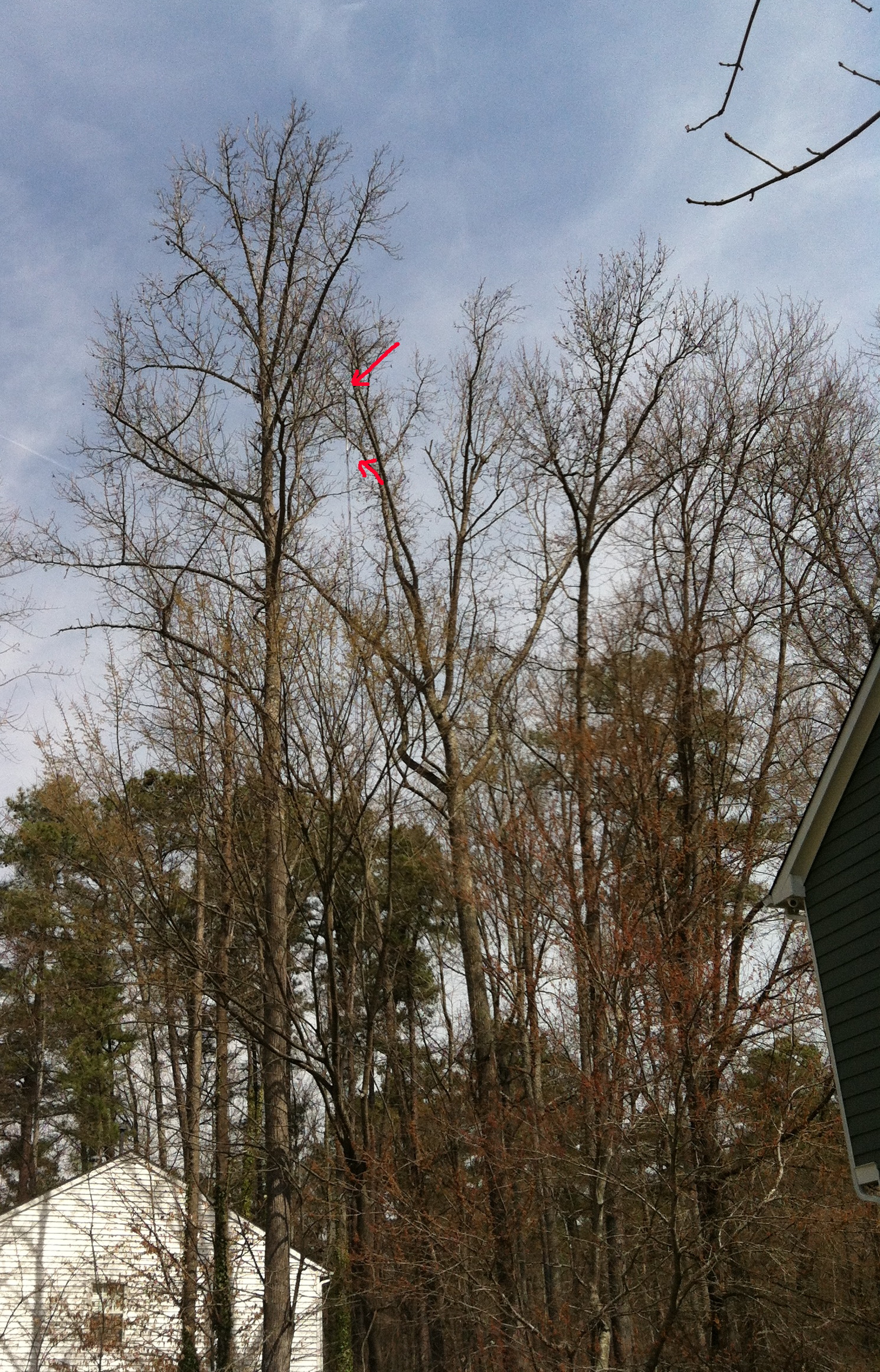| home | builders |
| builders ➜ Antennas |
Tower and masts may afford a top mounted omnidirectional vertical as well as end-mount yagis, or even room for a 6meter horizontal yagi.
Attics can afford multiple high frequency yagis and maybe a 1/4 wave ground plane for 6meters. Attics are best for high frequencies however because in-house noise tends to make 6meters deaf and sometimes even 2meters is impacted.
Roof mounts with room for only one omnidirectional vertical can still have multiple radio links by using a multi-band antennas.
Tree mounted antennas can be positioned in several ways, hung from a rope, top-of-tree placement, side-arm placement.
Side-arms are great for short yagis and omnis designed to be mast or tower mounted.
Rope hung antennas must usually be omnidirectional verticals, though with a little ingenuity a yagi may also be suspended.
Hy-Gain end-mount 5 element vertical 2m yagi, VB-25FM.
Gigaparts has the VB-25FM for about $99
The left photo is from the TADD node. The right is from the FIN node.
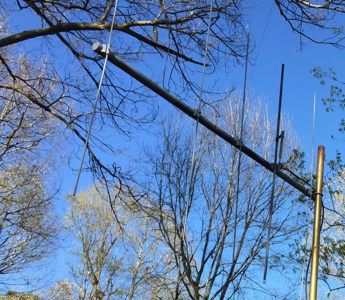
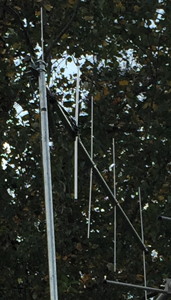
Arrow Antennas makes and sells a decent end-mount yagi for 220, and for 440Mhz.
They also have a center mount (horizontal) 2m yagi and 6m yagi.
Here, from the TADD node, are the 220-5s 220Mhz antenna, mounted horizontal in this case, and below it is the 440-5s 440Mhz Arrow antenna, mounted vertical.
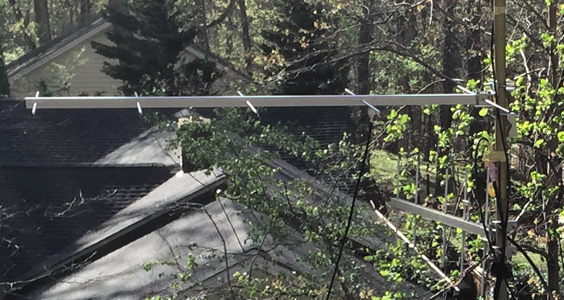
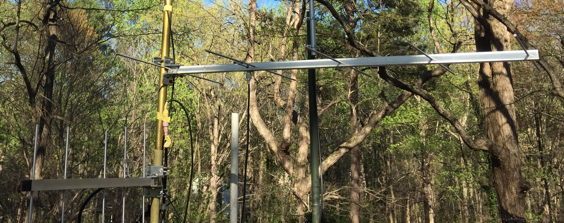
| More TADD node pix.
Click on the image to see a few more images and descriptions.
Antennas shown are:
The white pole in the middle was the mount for an experimental antenna, now removed. |
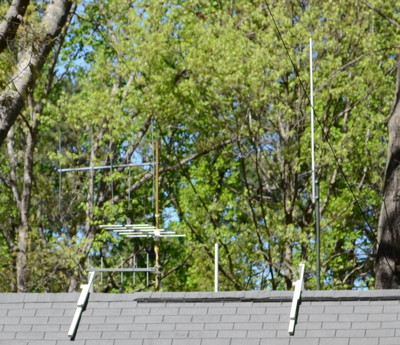
|
Fin NC4FG's Arrow 440-5s antenna shown with a Kenwood UHF mobile radio and bar stool for scale. .
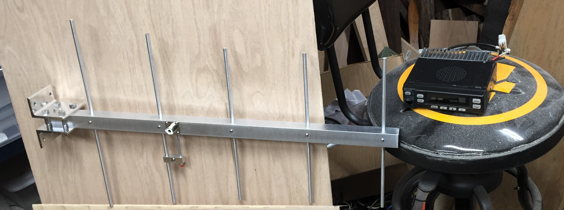
AES Ham Radio sells Comet, Cushcraft, Diamond, High Gain, Elk, M2, and MFJ yagi antennas
Gigaparts has very competitive prices.
If you have a rigid mount available, end-mount Yagis are much nicer than the multi-band omni antenna.
In some cases, height is better than gain, but gain sure is nice.
|
Diamond makes a pair of nice looking yagis, a144s5 and a430s10. The cost about $55 each. They are each equipped for horizontal mounting. For vertical mounting you need a side mount bracket / side-arm. Diamond sells this as an accessory for about $25! The a430s10 is made for 432Mhz and is out of its useful frequency range in the 440 to 450 FM band. It works well at 433.1Mhz. There is one in use at the AARON node site in Knightdale. The a144s5 seems to work quite well -- One is in use at the DAVIS node in Apex, but he had to buy the side-arm. The a430s10 may be assembled in about 2 minutes without tools. If you have a link which can use a yagi on each end and can be supported by 435Mhz radios, this may be the way to go. One notable feature is that the antenna tuning is fixed. It takes no time at all to tune it, because you can't. The A430s10 is good for the 433.1 to 433.9 Mhz frequency range. |
Diamond A430s10 mounted horizontal at AARON node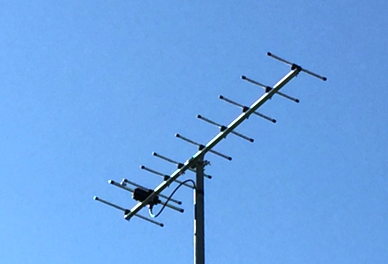
|
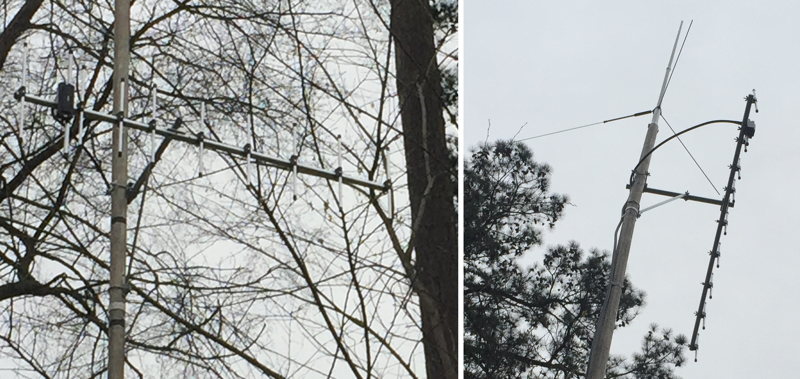
Here is the Diamond A144s5 mounted below several HF and VHF antennas at the DAVIS node.
The HF beam is not as close to the 2m yagi as it looks. The HF beam is very long.
The A144s5 is shown in vertical mode with the KB144 side-arm accessory:
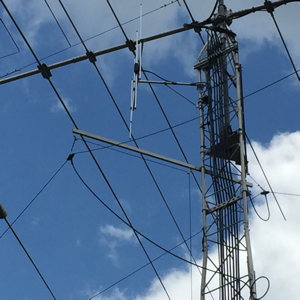
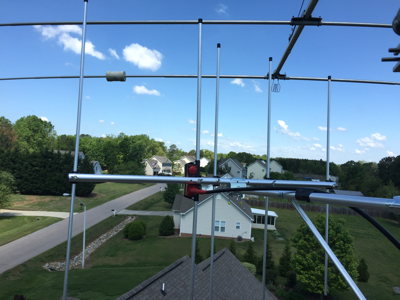
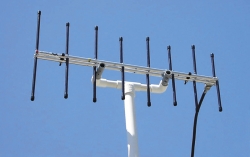
You need to have Hard hats, Fishing line, Plumbers string (bright colored), Ropes, Pully, Gloves to grip roap. 5" long 3/8" ScrewEye, Shooter, Shooting device, Weight, Tape, Tie wraps. Coax on roll, pipe to support the coax roll.
Getting Started
This process involves physical manipulation of objects which have real weight and which if allowed to fall on an unprotected head
or face could be hazardous. Take appropriate precautions! Especially be aware of falling branches.
First you need to put a fishing line over the tree or over the appropriate branch.
Use a slingshot or tennis ball cannon with a tennis ball or a fishing sinker.
Once you get a string over the tree appropriately, you need to use
the fishing line to pull a plumbers string over the tree.
At this point put your hard hats on and take appropriate caution.
Your coax should be on a spool about 20' away from under falling branches and the spool should be supported through a pipe or pole. Don't hurt your coax or your fingers.
Use the plumbers line to pull 550 paracord or equivalent. I like the Synthetic Textiles 770 pound stuff myself.
Pull the 550 over the path of your string, and through an eye bolt screwed into the tree at the 6' level.
Tie a marine pulley appropriate for 550 paracord to the paracord such that it can be pulled up the tree by tugging on the rope coming
down the other side of the tree or branch. Tie the 550 paracord into a loop (call this the "loop paracord").
Put another paracord (pully paracord) through the pully and tie that to
the coax at the bottom of the antenna. I did that by wrapping the pully paracord around
the coax several times and then I taped it, and then tied at the bottom of the
antenna and then tied again at the top of the antenna.
The idea is that the strain of holding the coax weight is on the rope
and not on the antenna's coax connector.
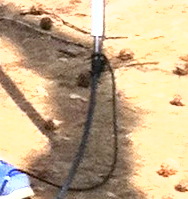
Now drag the pully up into the tree (falling branch hazard here!) by pulling down on the loop rope coming back down the tree.
Tie off the loop rope by making a bow of it and then knotting it through the eye bolt.
Use the pully rope to pull the antenna slowly up the tree while standing out of harms way!! (EXTREME falling branch hazard here) while your buddy stands well back out of falling branch range and makes sure the coax is unrolling properly.
Walk back a couple of dozen (more) yards. Take a photo of your work. Now you can think about taking off your hard hats.
Austin 144/220/440 antenna 80' up in tree
Click to zoom in